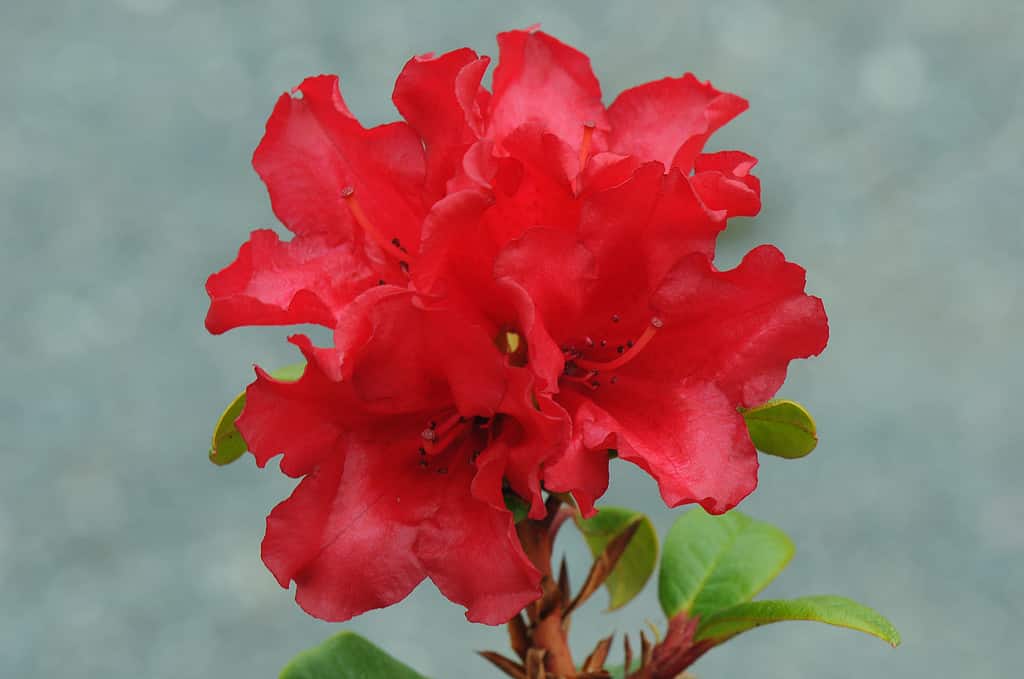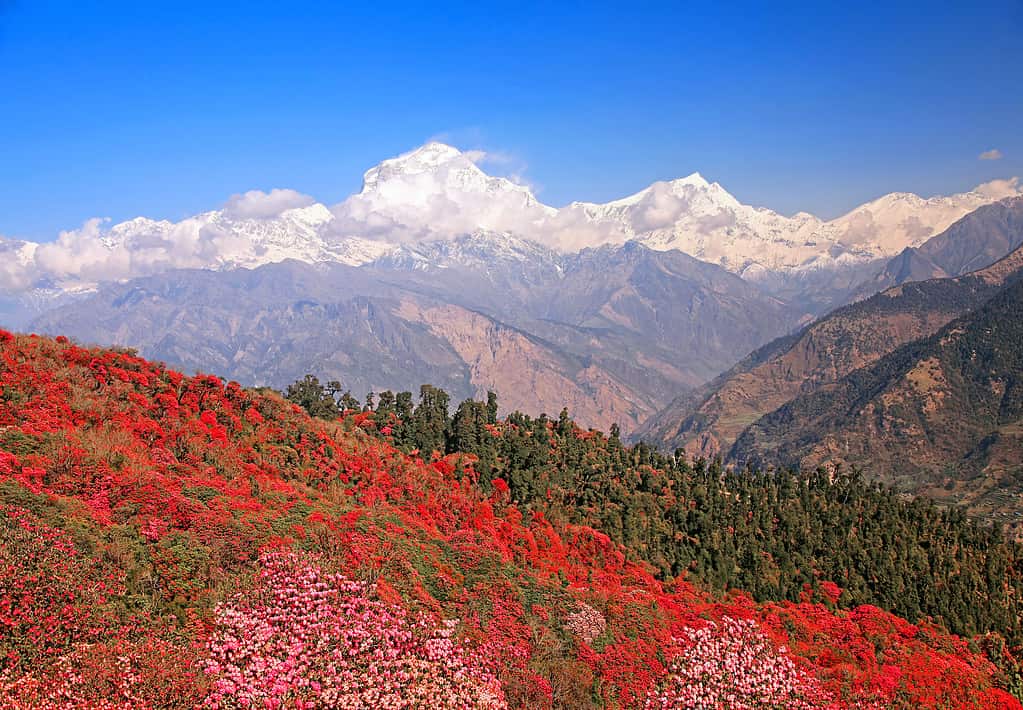Nepal is a unique Southeast Asian country of great mountains, incredible geographic features, and rich culture and tradition. This landlocked country shares borders with India and China. The Great Himalayas Range dominates its geography and has some of the world’s tallest mountains. This includes one of the most famous mountains in the world: Everest. Approximately 75% of Nepal’s landscape is mountainous. With the popularity of mountain climbing expeditions, Nepal has become a tourist destination. Thousands of people visit Nepal each year to climb some of the largest mountains in the world.
If they are lucky, these tourists may even see the national flower of Nepal: the gorgeous red Rhododendron arboreum. If you visit during the tree’s flowering season in the spring, why not hike a mountain trail where you can witness these trees in their full beauty, flowering against snowy mountains in the distance? This article is just a brief introduction to this national flower of Nepal. There is much more you can learn!
About Nepal
Nepal has climates ranging from subtropical to warm temperate climates to colder temperatures. In parts of the country within the mountains, temperatures remain below freezing, with constant snow and ice. Plant and animal life varies across the different mountain regions to the swampy plains. Many different ecosystems in Nepal contain immense biodiversity. In fact, the country is actually located in a biodiversity “hotspot” that allows for thousands of unique species to thrive.
As a geographically rugged mountainous country in a region of immense biodiversity, Nepal is home to many species. These are scattered across ecosystems, including forests, mountains, plains, grasslands, and wetland marshes. In fact, there are 118 different ecosystems in Nepal, classified by their altitude. Many of these are forest ecosystems. However, Nepal is very special in its role as a leader in community-based forestry. About 40% of the country’s population is involved with managing and restoring the country’s forest land. This collective action is essential to environmental conservation. It ensures that the country’s people can continue benefiting from the agricultural impacts, ecosystem goods, and resources provided by forests.

Approximately 75% of Nepal’s landscape is mountainous.
©TravellingNepal/Shutterstock.com
What Is the Rhododendron arboreum, Nepal’s National Flower?
Rhododendron arboreum is one of more than 1,000 other species in the Rhododendron genus. Another name of the national flower of Nepal, the Rhododendron arboreum, is “rhododendron tree.” This species of flowering tree grows in the Himalayan region of the world. In addition to growing in Nepal, you may find it growing in China, India, Myanmar, Pakistan, Thailand, and other nearby countries.
Plants of the Rhododendron genus often grows taller than 40 feet high in the wild, even reaching heights of 50 or 60 feet. However, when cultivated, they rarely grow taller than 40 feet. But the Rhododendron arboreum can grow very tall: the tallest specimen recorded in 1993 in India, on Mt. Jabfu, measured 108 feet tall! This speceis has a strong trunk, many branches, and leathery leaves. Each year, the tree blooms with white, pink, or vibrant red flowers. The bell-shaped flowers appear each spring in vibrant colors.
As the national flower of Nepal, the Rhododendron arboreum is known locally as lali gurans in Nepali. Lali gurans means “red rhododendron.” In Nepal, there are different varieties of rhododendrons, which bloom in many colors besides red. However, the Rhododendron arboreum is one of the most beloved. It was declared to be the national flower of Nepal in 2019. However, it has been associated with the culture and the Himalayan region for much longer.
What Does the Rhododendron arboreum Look Like?
The Rhododendron arboreum is a stunning species. The trees produce large, dark green leaves with pointed ends, which grow to be between 4 and 8 inches long and have a leather-like texture. The underside of these leaves features brown or gray-colored hairs. When the tree blossoms in the springtime, bright red flowers appear. These blooms are similar to bells in shape, about 2 inches across and 2 inches long. They have red petals with black nectar pouches on the inside. When cultivated in gardens or yards, the trees typically grow no higher than 40 inches tall. However, in the wild, they can reach much greater heights.

The
Rhododendron arboreumis a stunning species.
©Todd Boland/Shutterstock.com
Where Does the Rhododendron arboreum Grow?
In Nepal, the Rhododendron arboreum trees grow at elevations between 6,500 and 13,000 feet above sea level. You may find some specimens growing at 5,000 feet at the lowest. This allows the plants to thrive in the Himalayas of Nepal, but it can also grow in many other countries in Southeast Asia, including in south and western China, northern India, and throughout Nepal.
This species is very responsive to changes in temperature, making it susceptible to climate changes and requiring environmental conservation efforts. As a result, many different rhododendrons are considered endangered or vulnerable in parts of Southeast Asia, where they once grew in abundance. However, this species is one of the most resilient and grows more widely throughout Southeast Asia than any other rhododendron species, from the high Himalayan mountains to temperate regions in India and Sri Lanka.
The Rhododendron arboreum grows best in moist, humus-rich soil, in sun or shade conditions, and in places with good drainage. In Nepal, you may find Rhododendron arboreum growing in woodland forest areas or in the hills, with the snowy Himalayan mountains standing tall in the distance behind.
If you would like to discover the beauty of the Rhododendron arboreum flowers in the wild, try hiking through the mountains of Nepal during March, April, or May. These are the months when the trees typically bloom. Some popular Nepal hiking adventures that cover high elevations where you might find these trees blossoming are in the Milke Danda region, Langtang Valley, Poon Hill, or Ghandruk.
What Is the Cultural Significance of the National Flower of Nepal?
As the national flower of Nepal, the Rhododendron arboreum has a unique place in Nepali culture. The vibrant scarlet flowers show up each year as a sign of spring. Local people visit the hills and mountain regions to witness the trees in their full beauty. The locals will also gather the flowers to sell to tourists and city-dwellers in the markets. These flowers also adorn homes, businesses, and temples, while women and girls may wear them in their hair.
The Rhododendron arboreum is a species of religious significance to the people of Nepal and is considered sacred and an offering at religious temples.
As Nepal’s national flower, the country offers Rhododendron arboreum specimens to other countries to symbolize good diplomatic relations. You may see the bright red blossoms of the Rhododendron arboreum adorning the national currency and in folk art. However, while it is the national flower of Nepal, the Rhododendron arboreum also has significance in other neighboring countries where it grows in abundance. For example, the Indian Postal Service has issued special stamps commemorating the flower.
In addition to its aesthetic and cultural value, the Rhododendron arboreum has long been valued for medicinal purposes. Local businesses produce herbal tea from the flowers and traditional remedies from the plants. As a result, this species is an important part of local culture, the economy, and tourism — as visitors traverse walking trails to see the beautiful trees blossoming each year.

Stunning rhododendron blooming against snowy mountains in the distance, Himalayas, Nepal.
©Kiwisoul/Shutterstock.com
The photo featured at the top of this post is © Bencemor/Shutterstock.com
Thank you for reading! Have some feedback for us? Contact the AZ Animals editorial team.







